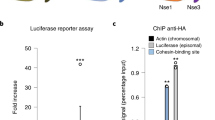Abstract
TRANSCRIPTIONAL silencing of the HM mating-type loci in the yeast Saccharomyces cerevisiae is caused by the localized formation of an altered chromatin structure, analogous to heterochromatin in higher eukaryotes. Silencing depends on cis-acting sequences, termed silencers, as well as several trans-acting factors, including histones H4 and H3, proteins RAP1 and ABF1, and the four SIR proteins (SIR1–4)1. Each of the four HM silencers contains an autonomously replicating sequence (ARS) to which the origin replication complex (ORC)2 binds. This six-protein complex is required for initiation of DNA replication, as well as for silencing3–7. Efficient establishment of the silenced state requires both passage through the S phase of the cell cycle8 and SIR1 protein9,10. Previous experiments suggested that SIR1 might be localized to the silencers by binding to ORC and/or RAP1 (ref. 11). Here we report that SIR1 can bind directly to ORC1, the largest of the ORC subunits, and that targeting of SIR1 to ORC1 at a silencer is sufficient to establish a silenced state.
Similar content being viewed by others
References
Laurenson, P. & Rine, J. Microbiol. Rev. 56, 543–560 (1992).
Bell, S. P. & Stillman, B. Nature 357, 128–134 (1992).
Foss, M., McNally, F. J., Laurenson, P. & Rine, J. Science 262, 1838–1844 (1993).
Bell, S. P., Kobayashi, R. & Stillman, B. Science 262, 1844–1849 (1993).
Micklem, G., Rowley, A., Harwood, J., Nasmyth, K. & Diffley, J. Nature 366, 87–89 (1993).
Fox, C. A., Loo, S., Dillin, A. & Rine, J. Genes Dev. 9, 911–924 (1995).
Loo, S. et al. Molec. Biol. Cell 6, 741–756 (1995).
Miller, A. M. & Nasmyth, K. A. Nature 312, 247–251 (1984).
Pillus, L. & Rine, J. Cell 59, 637–647 (1989).
Stone, E. M., Swanson, M. J., Romeo, A. M., Hicks, J. B. & Sternglanz, R. Molec. cell. Biol. 11, 2253–2262 (1991).
Chien, C. T., Buck, S., Sternglanz, R. & Shore, D. Cell 75, 531–541 (1993).
Hollenberg, S. M., Sternglanz, R., Cheng, P. F. & Weintraub, H. Molec. cell. Biol. 15, 3813–3822 (1995).
Chien, C. T., Bartel, P. L., Sternglanz, R. & Fields, S. Proc. natn. Acad. Sci. U.S.A. 88, 9578–9582 (1991).
Bell, S. P., Kobayashi, R. & Stillman, B. Cell 83, 563–568 (1995).
Moretti, P., Freeman, K., Coodly, L. & Shore, D. Genes Dev. 8, 2257–2269 (1994).
Hecht, A., Laroche, T., Strahl-Bolsinger, S., Gasser, S. M. & Grunstein, M. Cell 80, 583–592 (1995).
Studier, F. W., Rosenberg, A. H., Dunn, J. J. & Dubendorff, J. W. Meth. Enzym. 185, 5–89 (1990).
Loo, S. & Rine, J. Science 264, 1768–1771 (1994).
Author information
Authors and Affiliations
Rights and permissions
About this article
Cite this article
Triolo, T., Sternglanz, R. Role of interactions between the origin recognition complex and SIR1 in transcriptional silencing. Nature 381, 251–253 (1996). https://doi.org/10.1038/381251a0
Received:
Accepted:
Issue Date:
DOI: https://doi.org/10.1038/381251a0
- Springer Nature Limited
This article is cited by
-
The regional sequestration of heterochromatin structural proteins is critical to form and maintain silent chromatin
Epigenetics & Chromatin (2022)
-
Structural insight into the assembly and conformational activation of human origin recognition complex
Cell Discovery (2020)
-
Structure and function of the Orc1 BAH-nucleosome complex
Nature Communications (2019)
-
Nα-acetylated Sir3 stabilizes the conformation of a nucleosome-binding loop in the BAH domain
Nature Structural & Molecular Biology (2013)
-
Chromatin replication and epigenome maintenance
Nature Reviews Molecular Cell Biology (2012)





